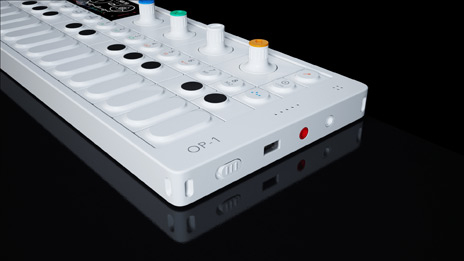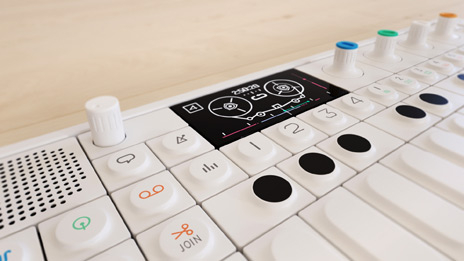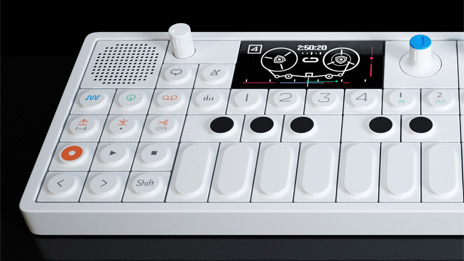But as more and more people started seeing this new synth—and the big gadget blogs start catching on—a nearly unprecedented level of anticipation started building. Eventually, an enigmatic website was launched, heralding the beginning of a long and exhaustive beta testing phase in which the subjects were sworn to secrecy—which served only to fan the flames of hype. Finally now in 2011, the unit is officially in production with the first two runs quickly selling out to anxious users across the globe. We got our hands on one and gave it a thorough work over to see if the hype was justified. Could 21st century tech make this thing a truly useful musical instrument or will it be relegated to the category of "expensive toy"?

To answer that question, you have to start out with what it does. It's a synth, a sampler, a four-track recorder, an effects unit, an FM radio, a microphone, a MIDI keyboard / sequencer, and it wraps it all up in a portable unit with an OLED display. If that sounds like a lot…well it kind of is. I like to think of the four-track tape-style recorder as the core unit of the OP-1. On it you can record almost anything—internal synth or sampler lines, or external signals via line-in, mic or FM radio. On their way to the tape decks, each of these sound sources can be run through a choice of four effect styles ranging from delays and reverbs to a lo-fi phone simulator. The speed of the tape can be adjusted while recording (or during playback) using one of the four knobs—you can even record while manually scrubbing the tape from a dead stop, which can yield some wild results.
Once you have some audio recorded (up to six minutes total record time available) you can then copy and paste sections of your composition from any or all of the four tracks to different parts of the arrangement, or into one of the sampler instrument slots. Each of the four tracks is single channel, mono only—which stays true to the classic four track recorders but is a slightly off-putting limitation for such a modern device. That negative is quickly overlooked when you start discovering the tricks that Teenage Engineering built into the tape recorder function and the fact that you can overdub to your heart's content with virtually no signal degradation.

Even though the tape recorder holds the central spot in the functional flow, you could easily ignore it and utilize the OP-1 as a standalone instrument because of the useful synth and sampler engines. On the synth side, there are 7 different engines to choose from, each of which employs its own unique UI layout with parameters controlled by the OP-1's four color-coded knobs. The synth UIs, along with the rest of the unique interface elements crafted by the Swedish designers, favor intuition and fun rather than the standard oscillator/envelope/filter paradigm found on most synthesizers. This in combination with the rather Spartan manual encourages users to experiment with the synth engines in order to get accustomed to what they can do. If you're the kind of person that needs to be able to dial exactly into the sound you have in your head, the OP-1 is probably not for you. If you're up for a little exploring though, the range of sounds you can achieve with the OP-1 and the immediate quality of the OLED screen and its UI is an experience to behold.
The synth and sampler sounds can be played with the keyboard, sequenced via MIDI over USB, or controlled by one of the three internal sequencer engines available on the OP-1. The first of these is called an "infinity" sequencer, which is sort of like an arpeggiator in that you can record a sequence of notes while holding the shift button. Then, when you hit any key, the sequence is triggered, transposed from that point on the keyboard. There is also a standard grid-based "pattern" sequencer which is useful for building drum patterns that can be played forward, backward and looped within themselves. (There is currently no way to synchronize it with the tape recorder's clock, however.) Finally, the quirkiest sequencer of the bunch is the "tombola," which captures notes as physical objects as you play them, dropping them into a rotating hexagon that retriggers the note each time it hits one of its walls. Kooky but fiercely unique and useful, a common theme for the OP-1.

Once you've had your fun with the OP-1 and have come out on the other end with something useful that you want to export to a DAW or share with others, things start to get rough though. (This is where the relative youth of the product rears its head.) While connected to USB the OP-1 can be switched into disk mode, giving access to each of the four tracks independently—without the EQ, effects or mixer settings applied. Alternatively, you can record your composition as you hear it in the master output to two sides of an "album" (the UI even shows a little vinyl record on a turntable), and these files can also be accessed in disk mode. The OP-1 does not yet sync to MIDI clock (although that feature is rumored to be on the horizon) and you can't easily mute or solo tracks—features that would have been helpful in recording the individual channels to a DAW. Even saving presets is a bit wonky, as it requires disk mode and a computer to save, rename and organize them.
So, is the OP-1 for everybody? There are certainly reasons to argue against it: the unorthodox sound design process, the early technical limitations preventing it from integrating easily with existing studio gear, the limited production numbers and the relatively high price. However, as evidenced by sales thus far, the OP-1's demographic is larger than anyone expected. I would be willing to bet that if you talked to a customer who snuck into the first handful of limited batches you would have a hard time convincing them to let theirs go. There is just something unique about it, visually and sonically. Most importantly, though, it's an instrument. You can take it with you, make some music on it and, in the process, you might catch yourself having some fun.
Ratings
Cost: 4/5
Versatility: 4.5/5
Sound: 5/5
Ease of use: 4.5/5

No comments:
Post a Comment